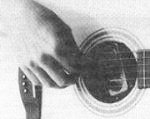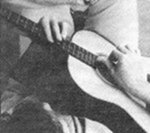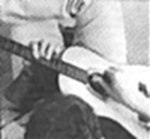Leo Kottke: Fingerstyle Visionary Learns From Tradition
by Mark Hanson
Page 2
 |
Not exactly. I do use classical position [Figure 1] when I need a certain tone for a piece. But my thumb is normally a little more parallel to the strings [Fig. 2 and 3]. Basically, I learned that you use everything in your arm to pick, not just our fingers. I found I could play with less force and get more sound. Finally my thumb notes started coming out, and my volume came back. I now have more dynamic range, and a lot more different colors to draw on. Another nice thing is that I never have to worry about losing a fingerpick at the last minute, or having one fly off into the audience. That used to happen, and I'd end up staggering my way to the end of the tune.
 |
No, I don't. I just pick the guitar up every day. I have to pick it up every day.
It's a compulsive sort of thing for you.
Yeah. Some days I'll practice for three hours or so. Then I'll pick it up later for another couple of hours. Other days I play for 10 minutes. The deciding factor is where or not I get that feeling in the back of my neck. If nothing is happening, then why belabor it?
Are your reading classical music?
 |
I've read some Fernando Sor. I've been reading some transcriptions of Mozart and Beethoven. I'd like to do more reading. But classical guitar is such a discipline. It's a bit daunting for me. I'd have to change quite a bit to really get into it. I couldn't do it because you can never bend a note [laughs].
Have you spent time studying music theory?
I've been working my way through the [jazz guitarist] George Van Eps method. I'm trying to play the stuff the way it is written, but he's built up these tortuous little chords that are just impossible.
What other kinds of material have you been studying?
I have a book from [jazz guitarist] Joe Pass. He included a catalog of jazz [musical] vocabulary that gives you most of the standard kinds of licks. I thought it was real gracious of the guy. Instead of your having to struggle for 10 years trying to learn some of this stuff, he just gives it to you. But I found that i needed a teacher. So I got together with a local classical guitarist and asked him to show me some harmonized scales.
Your recorded music isn't very scalar; it's more chordal with melodies. Why are you studying scales?
The whole point of all of this for me is improvisation. It will definitely help me in what I write, but I want to more flexible in playing with other people. I remember being on a tour with Linda Ronstadt. They asked me to come out and play some easy Hank Williams tune with them. I got completely lost. Part of the problem was that I was playing the 12-string tuned down two whole steps to C. So I was playing in some unfamiliar key. If I develop my ability to improvise, I'll be able to sit down and play with people like Linda and make some sense. It seems to me that the height of musicianship is to be able to play music by yourself and with other people.
What are some of the scales you're practicing?
I figured out the major scale fingerings across the strings all the way up the neck. I know where to put them for whatever key I'm in. [Kottke illustrates, playing an E major scale in several different positions on the neck, using two or three notes per string.] Now I'm connecting them. Then I can go all the way up or down the neck as I go across the strings. I've started making up exercises on the scales too. You're better off making up your own exercises, because that's what you draw on, anyway.
Do you ever alternate fingers in the right hand when you play your practice scales?
No. I've never really liked the sound of the rest stroke. [Ed. Note: In classical guitar terminology, a rest stroke is the technique of stopping the plucking fingers on an adjacent string after picking a note. Most popular-style fingerpickers use the "free" stroke -- NOT resting on another string -- most of the time.] And I don't really like alternating the thumb and index, either. The sound isn't even, to me.
What is your picking technique for scales?
I squeeze my thumb and index fingers together lightly, and use my index fingernail as a flatpick. I remember talking with [flamenco virtuoso] Paco de Lucia about [jazz innovator] John McLauglin. Paco -- of all people -- said, "Yes, I think maybe a plectrum is the way to play the guitar!" [Ed. note: In measure 73 of "Fisherman" on page 32
, readers can see that Kottke actually alternates the thumb and MIDDLE finger to play a scale. This technique was developed while Kottke was using fingerpicks, which precluded a quasi-flatpick technique.]